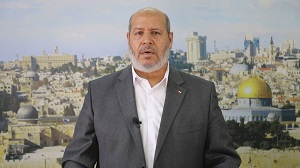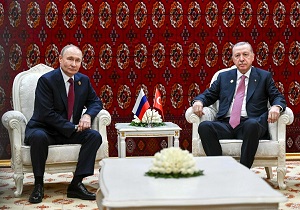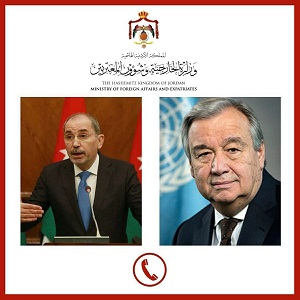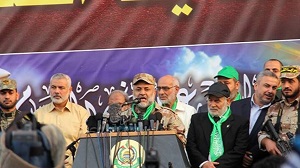Russia in Syria, a Double-Edged Sword - By Ibrahim Hamidi, Asharq Al-Awsat
What will happen if the United States decided to suddenly withdraw from northeastern Syria? What if Turkey carried out its threats and launched an attack in the north of the country?
What if a secret deal was made to hand over Deir Ezzor oil fields to Damascus in exchange for information from the latter about the missing US journalist Austin Tice?
In fact, Russia uses these scenarios to push opponents and belligerents to search for specific arrangements and to fill the American vacuum. Moscow is always trying to make a balance between the enemies. It uses Syria as a platform for negotiating goals on other issues in the region and the world. It has been doing this for years between Iran and Israel. It made some settlements in southern Syria, without reaching a final deal in the country. It doesn’t seek to stop the Iranian positioning and drones through the supply borders. It does not operate its missile systems against bombardment coming from Tel Aviv.
This equation has become known, although it is marred by several threats and limitations, the latest of which is the current tension between Russian President Vladimir Putin and Israeli Prime Minister Yair Lapid due to the latter’s statements about Russian “war crimes” in Ukraine and Moscow’s pressure on the Jewish Agency in Russia.
Therefore, the recent Israeli bombardment against Syrian targets and “Iranian drones” was a sign of Lapid’s determination to implement the “red lines.”
Since the direct intervention at the end of 2015, the Russian policy in Syria has been a “two-edged sword.” It promoted militarization between enemies and barely focused on politics. It reached compromises with foreign parties and disregarded the Syrian side. It used media and politics to cover the military option and the requirements of security proposals. In the three Syrian “states” under the “Russian umbrella,” arrangements were made between Washington and Moscow, Ankara and Moscow, Tel Aviv and Moscow, and between Tehran and Moscow.
There is also a fictional political line between the Syrian parties. It was tied in Geneva before Moscow decided to cut it off due to Switzerland’s stance in support of Ukraine.
What’s new about the “two-edged policy” is the secret Russian maneuver between Damascus and Ankara, and between Damascus and Qamishli. How?
Following a state of confusion and reluctance that prevailed over the former US administration, in the wake of the US withdrawal from Afghanistan, President Joe Biden’s administration showed more stability in its military survival in northeastern Syria. But it is important to stop at three developments:
First, after the attack on Ukraine, the Russian army has tried to test its US counterpart, pushing Washington to bilateral political and military dialogues and seeking to break the isolation because of Ukraine, knowing that a military agreement has been regulating their relationship in Syria since 2017.
Second, Turkish President Recep Tayyip Erdogan wants to take advantage of the growing importance of his role because of the “Ukraine swamp” to deal a severe blow to the Kurds in northern Syria.
Third, Biden promised the family of Tice to communicate directly with President Bashar al-Assad’s team in search of information about the journalist, who has been missing for nearly a decade.
Among the ideas that are currently circulated is handing over Deir Ezzor oil to Damascus as a negotiating start, taking into consideration that Trump’s envoys had offered, in the summer of 2019, military withdrawals from northeastern Syria in exchange for the release of Tice.
In these signs, Moscow found an opportunity. It organized private security talks between Damascus and Ankara, aimed at reaching arrangements and cooperation between the two parties against the PKK and terrorism in northern Syria.
One of the options that are actually on the table is the revival of the Adana Agreement, which was signed in 1998 and allowed the Turkish army to penetrate five kilometers into the Syrian depth to chase Kurdish fighters.
Undoubtedly, Syria has changed, so did the region and the world. Russian-led negotiations aim to search for a modified version of the agreement. There is no doubt that the tripartite summit in Tehran, which was marked by the visit of Syrian Foreign Minister Faisal Meqdad, gave an additional impetus to the Ankara-Damascus line under Moscow’s cover.
What is remarkable and unsurprising is that Moscow is sponsoring in parallel another agreement between Damascus and the Syrian Democratic Forces (SDF), in which the first line of mediation is supposed to be against the SDF main component, the Kurdish People’s Protection Units.
Here, the Hmeimim base sponsored talks to implement a memorandum of understanding that was completed in October 2019 between the commander of the Syrian Democratic Forces, Mazloum Abdi, and the director of national security, Major General Ali Mamlouk. Back then, the SDF hesitated to implement all the terms of the memorandum after the US agreed to postpone the withdrawal and extend the stay.
Now, the SDF is ready to implement these provisions. Up to 574 Syrian soldiers have been deployed in various areas near Al-Malikiyah, the Syrian-Iraqi-Turkish triangle, Ain Al-Arab (Kobani), Ain Issa and Manbij in the countryside of Aleppo, with the aim to form a deterrent force against Turkish desires.
In parallel, Western capitals are considering the need to start developing a “Plan B” in case of a military withdrawal, to prevent the recurrence of the Afghanistan experience.
The West is also advising the SDF to search for agreements and arrangements with Damascus, “because we will leave sooner or later.” As for Damascus, information indicates that no political talks will be held imminently. Military arrangements are possible, but political concessions are out of the question.
It is true that negotiations between Damascus and Qamishli in 2018, revealed differences over the future of the SDF, the Autonomous Administration, the border crossings, the language and symbols; but so far, Damascus is still reluctant to accept the Russian solutions, which Moscow repeat on every occasion.
The US conducted exercises, alerts, landings and assassinations east of the Euphrates. Israel bombed Iranian drones near Damascus. Turkish planes bombarded Kurdish targets in northern Syria, while opposition drones targeted the Hmeimim base in the west of the country.
Russian planes bombed the “Turkish region” in the northwest of the country. All of this is taking place in Syria, hours after the tripartite summit in Tehran and the Turkish mediation between Ukraine and Russia to conclude a “grain deal,” and Moscow’s success in “burying” the intra-Syrian Geneva process.
Intricate elements further complicate the Syrian puzzle, maximizing the suffering and the illusions of Syrian fates.
Latest News
-
 Hamas marks 38th anniversary, rejects all forms of guardianship over Palestinians
Hamas marks 38th anniversary, rejects all forms of guardianship over Palestinians
-
 Erdogan warns Black Sea should not be 'area of confrontation' after strikes
Erdogan warns Black Sea should not be 'area of confrontation' after strikes
-
 Indonesia flood death toll passes 1,000 as authorities ramp up aid
Indonesia flood death toll passes 1,000 as authorities ramp up aid
-
 Safadi, UN Chief highlight vital role of UNRWA, call for continued humanitarian aid to Gaza
Safadi, UN Chief highlight vital role of UNRWA, call for continued humanitarian aid to Gaza
-
 'Israel' targets Hamas commander in Gaza strike
'Israel' targets Hamas commander in Gaza strike